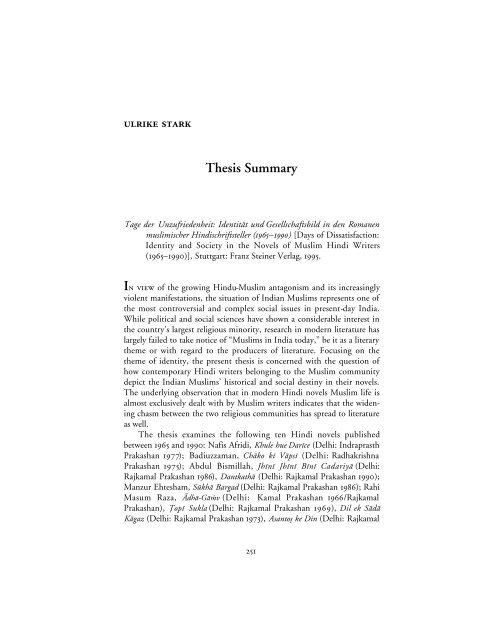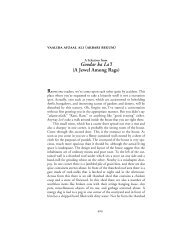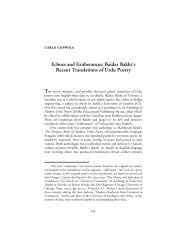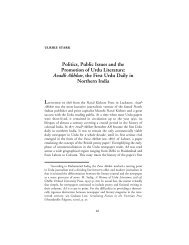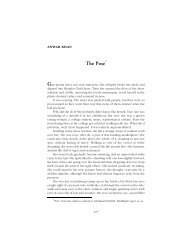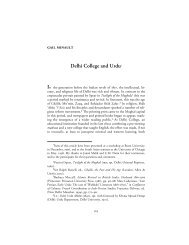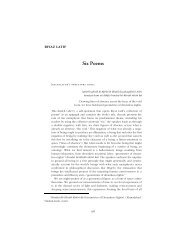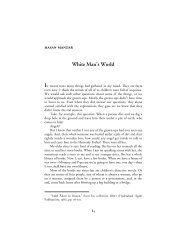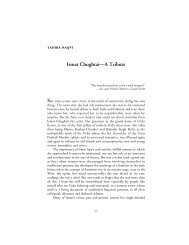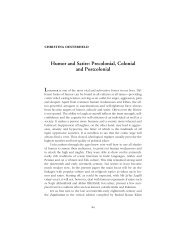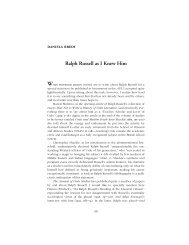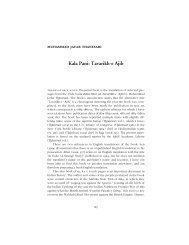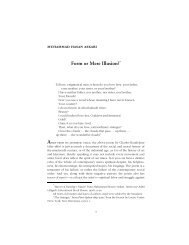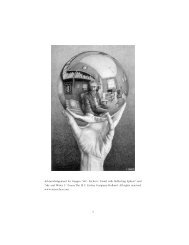Thesis Summary - the Annual of Urdu Studies
Thesis Summary - the Annual of Urdu Studies
Thesis Summary - the Annual of Urdu Studies
Create successful ePaper yourself
Turn your PDF publications into a flip-book with our unique Google optimized e-Paper software.
ULRIKE STARK<strong>Thesis</strong> <strong>Summary</strong>Tage der Unzufriedenheit: Identität und Gesellschaftsbild in den Romanenmuslimischer Hindischriftsteller (1965–1990) [Days <strong>of</strong> Dissatisfaction:Identity and Society in <strong>the</strong> Novels <strong>of</strong> Muslim Hindi Writers(1965–1990)], Stuttgart: Franz Steiner Verlag, 1995.IN VIEW <strong>of</strong> <strong>the</strong> growing Hindu-Muslim antagonism and its increasinglyviolent manifestations, <strong>the</strong> situation <strong>of</strong> Indian Muslims represents one <strong>of</strong><strong>the</strong> most controversial and complex social issues in present-day India.While political and social sciences have shown a considerable interest in<strong>the</strong> country’s largest religious minority, research in modern literature haslargely failed to take notice <strong>of</strong> “Muslims in India today,” be it as a literary<strong>the</strong>me or with regard to <strong>the</strong> producers <strong>of</strong> literature. Focusing on <strong>the</strong><strong>the</strong>me <strong>of</strong> identity, <strong>the</strong> present <strong>the</strong>sis is concerned with <strong>the</strong> question <strong>of</strong>how contemporary Hindi writers belonging to <strong>the</strong> Muslim communitydepict <strong>the</strong> Indian Muslims’ historical and social destiny in <strong>the</strong>ir novels.The underlying observation that in modern Hindi novels Muslim life isalmost exclusively dealt with by Muslim writers indicates that <strong>the</strong> wideningchasm between <strong>the</strong> two religious communities has spread to literatureas well.The <strong>the</strong>sis examines <strong>the</strong> following ten Hindi novels publishedbetween 1965 and 1990: Nafis Afridi, Khule hue Darµce (Delhi: IndraprasthPrakashan 1977); Badiuzzaman, Ch≥ko kµ V≥psµ (Delhi: RadhakrishnaPrakashan 1975); Abdul Bismillah, Jhµnµ Jhµnµ Bµnµ Cadariy≥ (Delhi:Rajkamal Prakashan 1986), Dantkath≥ (Delhi: Rajkamal Prakashan 1990);Manzur Ehtesham, S∑kh≥ Bargad (Delhi: Rajkamal Prakashan 1986); RahiMasum Raza, ¥dh≥-G≥v (Delhi: Kamal Prakashan 1966/RajkamalPrakashan), ºopµ Sukla (Delhi: Rajkamal Prakashan 1969), Dil ek S≥d≥K≥gaz (Delhi: Rajkamal Prakashan 1973), AsantoΩ ke Din (Delhi: Rajkamal251
252 • THE ANNUAL OF URDU STUDIESPrakashan 1986); Shani, K≥l≥ Jall (Delhi: Akshar Prakashan 1965/NationalPublishing House 1986).In view <strong>of</strong> <strong>the</strong> authors’ openly expressed secular if not irreligious outlookand <strong>the</strong>ir leftist leanings, <strong>the</strong> categorization <strong>of</strong> <strong>the</strong>m as “Muslims”can only refer to <strong>the</strong>ir Muslim family background and cultural affiliation.The writers’ critical intellectual distance, however, is taken to qualify<strong>the</strong>m as important “participant-observers” <strong>of</strong> <strong>the</strong>ir own social and religiouscommunity.The study is divided into six chapters. Chapter 1 serves as an introductionto <strong>the</strong> complex question <strong>of</strong> Muslim identity in India, pointing to<strong>the</strong> fact that Indian Muslims are a heterogeneous and highly diversecommunity. The term “identity” as used here is based on E.H. Erikson’sconcept <strong>of</strong> “subjective experience <strong>of</strong> continuity,” 1 <strong>the</strong> role-and-interactionmodel <strong>of</strong> sociology, 2and Erving G<strong>of</strong>fman’s three-fold typology <strong>of</strong>identity as social, personal and ego identity. 3 The writers are <strong>the</strong>n introduced.Although not viewing <strong>the</strong>mselves as a distinct group, <strong>the</strong>y areunited in challenging <strong>the</strong> distorted picture <strong>of</strong> a Muslim identity definedexclusively on religious grounds. Chapter 2 gives a short summary <strong>of</strong> eachnovel. Chapters 3 and 4 deal with content and <strong>the</strong>mes, focusing on <strong>the</strong>factors that emerge as constitutive features <strong>of</strong> Muslim identity as well ason <strong>the</strong> political, social and economic circumstances that, according to <strong>the</strong>writers, have posed a threat to this identity in <strong>the</strong> recent past. Two mainidentity-related phenomena can be distinguished in <strong>the</strong> novels: an externalmenace to identity due to general developments in Indian society, andan internal process <strong>of</strong> identity change within <strong>the</strong> Muslim community.Hence <strong>the</strong> separation into an outer (ch. 3) and an inner world (ch. 4).Chapter 5 deals with <strong>the</strong> symbolic and metaphorical representation <strong>of</strong>both shattered and preserved identity in four specific novels. Chapter 6 isdevoted to questions <strong>of</strong> literary aes<strong>the</strong>tics and narrative technique, i.e.narrative structure, point <strong>of</strong> view, style and language. Against <strong>the</strong> background<strong>of</strong> <strong>the</strong> Hindi-<strong>Urdu</strong> controversy, <strong>the</strong> section on language combines1 Identity and <strong>the</strong> Life Cycle: Selected Papers, New York 1967 (1959).2 Krappmann, L., Soziologische Dimensionen der Identität. StrukturelleBedingungen für die Teilnahme an Interaktionsprozessen, Stuttgart 1973; Berger, P.L./Luckmann, T., Die gesellschaftliche Konstraktion der Wirklichkeit. Eine Theorieder Wissenssoziologie, Frankfurt a.M., 1980.3 Stigma: Notes on <strong>the</strong> Management <strong>of</strong> Spoiled Identity, Englewood Cliffs,N.Y., 1963.
ULRIKE STARK • 253an analysis <strong>of</strong> <strong>the</strong> authors’ individual literary language with <strong>the</strong> content-relatedquestion <strong>of</strong> how language is depicted as a central identityfactor in <strong>the</strong> novels.The novels clearly attest to <strong>the</strong> existence <strong>of</strong> an identity crisis amongIndian Muslims. The partition <strong>of</strong> India and <strong>the</strong> foundation <strong>of</strong> Pakistan in1947 are shown to be a crucial turning-point and traumatic rupture in<strong>the</strong>ir experience <strong>of</strong> continuity, resulting in individual suffering, <strong>the</strong> breakup<strong>of</strong> families, <strong>the</strong> sudden loss <strong>of</strong> social status, and political disorientation.While <strong>the</strong> Muslims remaining in India are depicted as <strong>the</strong> realvictims <strong>of</strong> Partition, those who migrate to Pakistan meet with disappointment,since Pakistan cannot fulfill <strong>the</strong> dream <strong>of</strong> a new homeland,even though it may provide security and material comfort. The youngerwriters are concerned with <strong>the</strong> difficult historical legacy <strong>of</strong> Pakistan: <strong>the</strong>stigmatization <strong>of</strong> Muslims in India, due to persistent suspicion <strong>of</strong> <strong>the</strong>irnational loyalty, is seen as one <strong>of</strong> <strong>the</strong> gravest consequences <strong>of</strong> Partition.Deeply resentful <strong>of</strong> this mistrust, <strong>the</strong> authors challenge it by asserting<strong>the</strong>ir genuine commitment to India and emphasizing <strong>the</strong> Indian Muslim’sright to his hereditary homeland.The majority <strong>of</strong> <strong>the</strong> writers express a pessimistic view <strong>of</strong> society, seenin <strong>the</strong> protagonist’s social failure and <strong>the</strong> lack <strong>of</strong> a happy ending. In anumber <strong>of</strong> novels a “frustrated young man” serves as a paradigm for <strong>the</strong>process <strong>of</strong> disillusionment that Indian society underwent soon afterIndependence. Frustrated hopes and a thorough disappointment with <strong>the</strong>political and social structures <strong>of</strong> postcolonial India lead this characterfrom committed idealism ei<strong>the</strong>r to resignation or into <strong>the</strong> hands <strong>of</strong> <strong>the</strong>fundamentalists. Those novels that in <strong>the</strong> tradition <strong>of</strong> progressivist writingdeal with <strong>the</strong> living conditions <strong>of</strong> <strong>the</strong> Muslim proletariat show an onlysubdued social-reformist optimism. With Marxist ideology no longerregarded as a path to salvation, <strong>the</strong> writers demand reforms from within<strong>the</strong> Muslim community and stress <strong>the</strong> need for education if social conditionsare to be changed. The struggle for jobs, economic resources, andpolitical dominance fought between castes and religious groups appears asan up-to-date variant <strong>of</strong> <strong>the</strong> class conflict. It leads to a continuous fragmentation<strong>of</strong> Indian society into different interest groups, a processperceived as dangerous. In this context, <strong>the</strong> novels aim to show thatHindu-Muslim conflicts, seemingly motivated by religion, are, in actualfact, part <strong>of</strong> this larger power struggle.The frustration with <strong>the</strong> political establishment and <strong>the</strong> deep lack <strong>of</strong>confidence in <strong>the</strong> state expressed in <strong>the</strong> novels is very pervasive in modernHindi literature and does not reflect a specifically Muslim viewpoint.
254 • THE ANNUAL OF URDU STUDIESIronically distorted or reduced to a caricature, <strong>the</strong> stock character <strong>of</strong> acorrupt politician lusting for power mirrors <strong>the</strong> failure <strong>of</strong> political partiesand <strong>the</strong> decadence <strong>of</strong> political culture in India today.One central <strong>the</strong>me emerging from <strong>the</strong> novels is <strong>the</strong> deterioration <strong>of</strong>Hindu-Muslim relations. The destruction <strong>of</strong> traditional structures <strong>of</strong>peaceful coexistence serves to exemplify how <strong>the</strong> virus <strong>of</strong> communalismhas spread in both public and private life. Love relationships betweenmembers <strong>of</strong> <strong>the</strong> two different religious groups are generally foredoomedto failure. In <strong>the</strong>ir plea for mutual tolerance, and in depicting both modelfriendships between Hindu and Muslim as well as <strong>the</strong> absurdity <strong>of</strong> commonprejudices and <strong>the</strong> mechanism <strong>of</strong> communal agitation, <strong>the</strong> novelstake a clear stand against communalism. While openly condemning violence,<strong>the</strong> authors describe <strong>the</strong> dubious role <strong>of</strong> politicians and fundamentalistorganizations in instigating communal conflict. It is not religiousdifferences, but <strong>the</strong> failure <strong>of</strong> politics and state organizations, economicproblems and <strong>the</strong> machinations <strong>of</strong> criminal elements that are shown to be<strong>the</strong> real reasons behind so-called communal riots. The more recent novelsbear witness to <strong>the</strong> increase in violent confrontations and depict <strong>the</strong>Muslim’s fear for his life as a new aspect <strong>of</strong> endangered identity.Several novels treat <strong>the</strong> social decline brought about by political andsocio-economic changes as an important aspect <strong>of</strong> <strong>the</strong> Muslim identitycrisis. As a simultaneous loss <strong>of</strong> property and <strong>of</strong> social status, this declinetakes an especially drastic form in <strong>the</strong> case <strong>of</strong> <strong>the</strong> former Muslim élitegroups, viz., <strong>the</strong> north Indian landlords and <strong>the</strong> educational élite, recruitingitself from lawyers and court <strong>of</strong>ficials. The vast masses <strong>of</strong> <strong>the</strong> Muslimpopulation naturally appear excepted from this particular identity crisis.They are shown, however, to be afflicted by poverty and social misery.The wide-ranging attention paid by <strong>the</strong> authors to social, economicand cultural factors <strong>of</strong> identity contrasts with <strong>the</strong> comparatively scanttreatment <strong>of</strong> questions concerning Islamic faith and dogma. The authors’attitudes towards religion are summed up in a critical inquiry into <strong>the</strong>meaning and function <strong>of</strong> religion in a society marked by severe socialproblems. The portrayal <strong>of</strong> religious identity, now objective, now ironicallydistanced, focuses on everyday religious life and customs, thus creatingan image that contrasts with <strong>of</strong>ficial, “high-tradition” Islam. Religiousfestivals, fairs, and devotion to saints and martyrs serve to exemplify <strong>the</strong>Indian Muslims’ roots in indigenous religious traditions and <strong>the</strong> synchretisticcharacter <strong>of</strong> <strong>the</strong>ir religious identity.In discussing <strong>the</strong> hierarchical social stratification <strong>of</strong> <strong>the</strong> IndianMuslim community several authors describe a phenomenon unique to
ULRIKE STARK • 255India, though contrary to <strong>the</strong> basic tenets <strong>of</strong> Islam. While depicting affiliationto caste or status group as a main factor <strong>of</strong> social identity and aneffective way <strong>of</strong> in-group ranking, <strong>the</strong> authors condemn or ridicule allnotions <strong>of</strong> caste superiority. Élitist insistence on superiority <strong>of</strong> birth isperceived as a hindrance to <strong>the</strong> community’s progress and contrasted with<strong>the</strong> actual moral decadence <strong>of</strong> <strong>the</strong> groups ranking at <strong>the</strong> top <strong>of</strong> <strong>the</strong> socialhierarchy. The gradual decay <strong>of</strong> this hierarchy is shown to cause seriousidentity problems in <strong>the</strong> case <strong>of</strong> <strong>the</strong> Sayyid élite.The writers’ look at <strong>the</strong> inner world focuses on <strong>the</strong> changes <strong>the</strong>Muslim family is undergoing. A mirror <strong>of</strong> society, <strong>the</strong> family appears nolonger able to provide <strong>the</strong> individual with security, orientation or a set <strong>of</strong>values. Sacred notions <strong>of</strong> family life are systematically destroyed in some<strong>of</strong> <strong>the</strong> novels. Through <strong>the</strong> example <strong>of</strong> archetypal role-conflicts betweenparents and child, husband and wife, mo<strong>the</strong>r-in-law and daughter-in-law,<strong>the</strong> authors show how traditionally sanctioned structures <strong>of</strong> power andrepression encourage moral misbehavior, lead to <strong>the</strong> inner decay <strong>of</strong> <strong>the</strong>family, and bring forth individuals with problematic personalities.The situation <strong>of</strong> Muslim women receives special attention in <strong>the</strong>novels. It is conspicuous that <strong>the</strong> authors accord only a secondary role tocontroversial Islamic <strong>the</strong>mes such as πal≥q, purdah or polygamy, andinstead focus on general manifestations <strong>of</strong> injustice against women in apatriarchal society. The portraits <strong>of</strong> female characters in <strong>the</strong> novels illustrateboth <strong>the</strong> tedious everyday life <strong>of</strong> traditional women who submissivelyacquiesce in <strong>the</strong>ir age-old role, as well as <strong>the</strong> changingself-perception <strong>of</strong> a new generation <strong>of</strong> young Muslim girls who boldlyquestion <strong>the</strong> traditional role model. The endeavors <strong>of</strong> <strong>the</strong>se girls toachieve independence and self- determination in <strong>the</strong>ir love relationshipsinevitably lead to a clash with <strong>the</strong>ir tradition-bound environment. Theauthors make concessions to reality and prevailing moral standards bygenerally letting <strong>the</strong>se young women fail in <strong>the</strong>ir aspirations or having<strong>the</strong>m meet with a tragic end. Nowhere in <strong>the</strong> novels, however, is <strong>the</strong>re anexplicit condemnation <strong>of</strong> behavior that could be regarded as “disobedient”or “immoral.” Instead, <strong>the</strong> authors clearly support women’s rightto self-determination and emphasize <strong>the</strong> importance <strong>of</strong> education inimproving <strong>the</strong>ir lot.Endangered identity as a central individual and collective experience<strong>of</strong> Indian Muslims is represented by different kinds <strong>of</strong> symbolism in <strong>the</strong>novels <strong>of</strong> Raza, Ehtesham and Shani. With <strong>the</strong>ir common negative connotations<strong>the</strong> symbols <strong>of</strong> Moharram, black water and <strong>the</strong> dried-up banyantree reflect cultural and social decline, <strong>the</strong> uprooting and insecurity <strong>of</strong>
256 • THE ANNUAL OF URDU STUDIESMuslims in India. An entirely different picture emerges from a novel byBismillah, where <strong>the</strong> religious symbolism <strong>of</strong> weaving is used as an illustration<strong>of</strong> asserted identity and as an aes<strong>the</strong>tic counterpart to <strong>the</strong> criticalsocial content <strong>of</strong> <strong>the</strong> novel.The writers share roots in <strong>the</strong> tradition <strong>of</strong> literary realism. This isreflected in a common aes<strong>the</strong>tic approach: depiction <strong>of</strong> reality that laysclaim to documentary truth, love <strong>of</strong> realistic detail, emphasis on everydaylife, and commitment to social <strong>the</strong>mes. The novels show a clear preferencefor scenic representation with its aes<strong>the</strong>tic effect <strong>of</strong> immediatenessand au<strong>the</strong>nticity; <strong>the</strong> influence <strong>of</strong> regionalism is noticeable in a concept <strong>of</strong>space limited to <strong>the</strong> representation <strong>of</strong> one’s own private sphere <strong>of</strong> experience,i.e., a specific microcosm. Apart <strong>the</strong>m <strong>the</strong>se similarities, however,considerable differences can be noted regarding <strong>the</strong> artistic expressivenessand <strong>the</strong> authors’ <strong>the</strong>oretical claim to <strong>the</strong> narrative structure <strong>of</strong> <strong>the</strong> novel.Specific novels are analyzed with a view to <strong>the</strong> aes<strong>the</strong>tic implications <strong>of</strong>compositional techniques and narrative discourse. Particular aspects thatare discussed include <strong>the</strong> aes<strong>the</strong>tically effective harmonization <strong>of</strong> contentand form, <strong>the</strong> extreme condensation <strong>of</strong> <strong>the</strong> time-space structure as aformal expression <strong>of</strong> existentialist concepts, <strong>the</strong> conceptualization <strong>of</strong> <strong>the</strong>time problem by means <strong>of</strong> an adequate discursive time structure, but also<strong>the</strong> lack <strong>of</strong> artistic dexterity in applying basic narrative techniques.Several novels serve as examples in <strong>the</strong> discussion <strong>of</strong> how specificnarrative perspectives and points <strong>of</strong> view are found suitable for <strong>the</strong> representation<strong>of</strong> reality and, especially, <strong>the</strong> treatment <strong>of</strong> identity as a literary<strong>the</strong>me. Multiple perspective conveyed through a combination <strong>of</strong>third-person narrative, interior monologue, direct speech and style indirectlibre appears as an effective device in <strong>the</strong> au<strong>the</strong>ntic and direct representation<strong>of</strong> a subjective world view. First-person narrative with its proximityto autobiography and inherent scope for self-reflection is shown to beespecially suited for <strong>the</strong> depiction <strong>of</strong> problematic or shattered identity. Aninteresting exception is <strong>the</strong> use <strong>of</strong> a self-conscious narrator in Raza’snovels, ironically pointing to <strong>the</strong> fictitiousness <strong>of</strong> <strong>the</strong> novel. Here, in acurious fashion, autobiographical identity problems fuse with fictionalidentity problems.The Hindi-<strong>Urdu</strong> controversy and <strong>the</strong> decline <strong>of</strong> <strong>the</strong> <strong>Urdu</strong> language,which represents an acute threat to <strong>the</strong> cultural identity <strong>of</strong> <strong>the</strong> Muslims innorth India, form <strong>the</strong> background for <strong>the</strong> discussion <strong>of</strong> <strong>the</strong> authors’ <strong>the</strong>oreticalstance in <strong>the</strong> language controversy, <strong>the</strong> use <strong>of</strong> language in <strong>the</strong>novels, and <strong>the</strong> treatment <strong>of</strong> language and identity as a <strong>the</strong>matic topic. AsMuslims who write in Hindi, <strong>the</strong> authors refute <strong>the</strong> widespread cliché
ULRIKE STARK • 257that Muslim identity finds its adequate literary expression in <strong>the</strong> <strong>Urdu</strong>language only. Instead, <strong>the</strong>y argue for <strong>the</strong> co-existence and mixing <strong>of</strong>Hindi and <strong>Urdu</strong> and refuse to grant <strong>the</strong> language issue prominence as afundamental ideological <strong>the</strong>me. This conciliatory attitude is reflected in<strong>the</strong> novels’ language usage, where Sanskritic and Arabo-Persian lexicalborrowings are employed in such a way that <strong>the</strong> distance between Hindiand <strong>Urdu</strong> appears to be bridged quite naturally.Raza and Ehtesham are found to be <strong>the</strong> only authors to deal with <strong>the</strong>discrimination against and decline <strong>of</strong> <strong>Urdu</strong> as an aspect <strong>of</strong> <strong>the</strong> Muslimidentity crisis and as a paradigm <strong>of</strong> <strong>the</strong> north Indian Muslims’ socialcondition. The o<strong>the</strong>r authors direct <strong>the</strong>ir attention to changing patterns<strong>of</strong> language use and to <strong>the</strong> present linguistic situation. They are concernedwith <strong>the</strong> penetration into Hindi <strong>of</strong> English vocabulary and <strong>the</strong>practice <strong>of</strong> code-switching as an indicator <strong>of</strong> <strong>the</strong> speaker’s aspirations for a“modern” identity. The issue <strong>of</strong> standard language versus dialect is givenprominence. It is reflected both in <strong>the</strong> narrative technique and <strong>the</strong> content<strong>of</strong> <strong>the</strong> novels: while mimesis, <strong>the</strong> claim to au<strong>the</strong>nticity, and localcolor govern <strong>the</strong> use <strong>of</strong> dialect in narration, dialect is depicted as a centralfactor in <strong>the</strong> characters’ regional, cultural and social identity. The use <strong>of</strong>dialect is shown to foster emotional integration and community identity.Against this, <strong>the</strong> dialect-speaker’s marginalization and his exclusion from<strong>the</strong> <strong>of</strong>ficial world <strong>of</strong> standard language are described as problematicaspects.The contribution made by Muslim writers to modern Indian literaturehas up to now been largely overlooked by modern literary studies.The present <strong>the</strong>sis is limited to <strong>the</strong> evaluation <strong>of</strong> a small group <strong>of</strong> Hindiwriters. While a more comprehensive examination is left to fur<strong>the</strong>rstudies, it can be concluded that in attempting an honest and aes<strong>the</strong>ticallygratifying portrait <strong>of</strong> <strong>the</strong> historical destiny, social situation and everydaylife <strong>of</strong> Muslims in north India, <strong>the</strong> authors discussed here have introduceda new <strong>the</strong>me into modern Hindi literature and made an importantstatement in <strong>the</strong> current debate on Muslim identity in India. ❐


